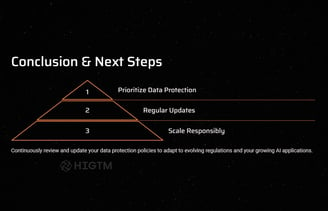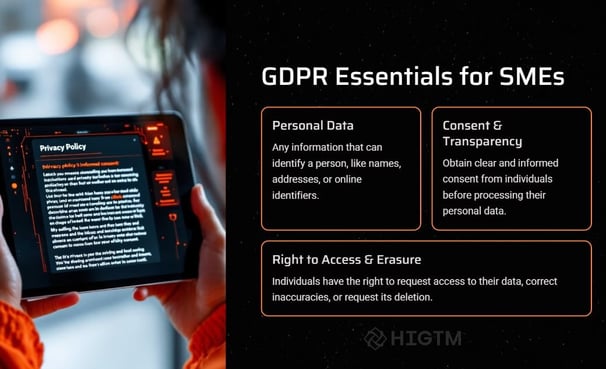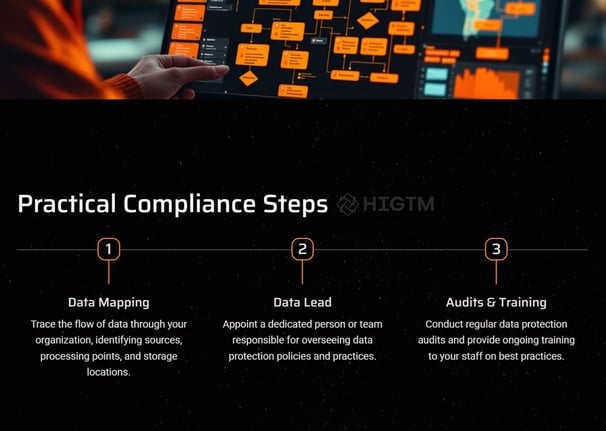27. Regulations & Compliance 101 – GDPR, Data Protection Basics
Laws like the General Data Protection Regulation (GDPR) often come across as complicated or bureaucratic. Small and medium-sized enterprises, especially those exploring AI, sometimes overlook the legal side in their rush to innovate. This article demystifies data protection basics. You’ll learn how GDPR operates, see practical tips for ensuring compliance, and discover how responsible data handling supports AI growth.
Q1: FOUNDATIONS OF AI IN SME MANAGEMENT - CHAPTER 1 (DAYS 1–31): CORE AI CONCEPTS & VALUE PROPOSITION
Gary Stoyanov PhD
1/27/20257 min read

1. Why Data Protection Matters for AI Initiatives
1.1 Trust & Reputation
Customers share personal data only if they trust you to keep it secure. One significant breach can tarnish your brand, and the damage goes beyond legal penalties. Concern spreads quickly in an era where data travels instantly through digital channels.
1.2 Legal Requirements
Regulations such as GDPR in the EU and other privacy laws worldwide enforce strict rules for collecting, processing, and storing personal data. Noncompliance can bring steep fines and forced halts to your AI usage. Vigilant planning keeps you safe.
1.3 Ethical Responsibility
AI often manipulates personal information. Whether it’s analyzing purchase history or tracking user behavior, there’s a moral dimension to ensure this data is used fairly. Following the correct protocols is a sign of organizational integrity.
2. Understanding GDPR Essentials
2.1 What is GDPR?
The General Data Protection Regulation is a major privacy law in the European Union. It affects any business that handles personal data of EU residents, regardless of the company’s own location. The key goal: protect people’s rights to control how their data is used.
2.2 Key Principles
Lawfulness, Fairness, and Transparency: Collect data only under valid legal grounds. Keep people informed about what you’re doing.
Purpose Limitation: Collect data for a specific purpose, not indefinite or unrelated uses.
Data Minimization: Gather only what’s necessary. More data invites more risk.
Accuracy: Keep personal data updated and correct.
Storage Limitation: Avoid storing data longer than required.
Integrity and Confidentiality: Protect data with security measures like encryption or secure servers.
2.3 Rights of Individuals
Data subjects (the people whose data you process) can ask to access their data, request corrections, or insist you erase it. If your AI system uses personal data, you must be ready to respond to these requests quickly.
3. Data Protection Basics Beyond GDPR
3.1 Importance of Consent
People need to give clear permission if you plan to use their personal data in AI. The days of hidden checkboxes are gone. A short statement and an “I Agree” button might suffice, but it must be explicit.
3.2 Secure Storage & Transfer
Encryption, role-based access, and strict password policies stop unauthorized eyes from viewing personal data. If you share information with third-party vendors, confirm they also respect data protection standards.
3.3 Data Minimization
Excess data is a vulnerability. If your AI pilot checks user behavior over time, define exactly which behavior metrics you need, and skip the rest. Less data means fewer potential leaks or compliance oversights.
4. Real-World Impact on SMEs
4.1 Penalties & Fines
GDPR can fine a company up to 4% of global annual turnover or €20 million, whichever is higher. Even smaller fines can cripple an SME. By adhering to essential guidelines, you avoid putting your entire operation at risk.
4.2 Trust & Competitive Advantage
When you show that you treat people’s data ethically, word spreads. Potential clients in a B2B context might trust you more if they see robust data policies. Strong compliance can separate you from competitors who handle data carelessly.
4.3 Streamlined Data Management
Compliant data flows often turn out more organized. You eliminate duplicates, archive older data systematically, and set up processes that ensure only the right people have access. That structure improves day-to-day efficiency.
5. Practical Steps to Implement GDPR and Basic Data Protection
5.1 Map Out Data Flows
Where Does Data Enter? Identify websites, in-person forms, or vendor files.
How is It Processed? Check if you use AI tools or manual sorting.
Where is It Stored? Note your servers, cloud platforms, or employees’ laptops.
This mapping shows which areas might be vulnerable, such as insecure email attachments or unprotected database logs.
5.2 Appoint a Data Lead
You don’t always need a formal Data Protection Officer if you’re small, but designating someone who oversees compliance helps. This person or partner can watch for new obligations, handle data subject requests, and train others.
5.3 Train Your Staff
Employees who handle personal data must know the do’s and don’ts. A short session on confidentiality, proper data disposal, and how to spot phishing attempts can prevent major mishaps.
5.4 Update Contracts & Vendor Agreements
If outside companies process data for you (like a cloud analytics vendor), ensure the contract states they comply with GDPR or relevant laws. Add clauses on data breach notifications and subcontractor responsibilities.
5.5 Regular Audits & Documentation
Document each step: how you collect consent, how you respond to data deletion requests, and how you encrypt personal information. This record-keeping shows your good faith if regulators ever ask.
6. AI-Specific Concerns
6.1 Ethical Data Sourcing
AI thrives on robust datasets. If these sets contain personal data, double-check that you have legitimate consent or other legal bases for using that information.
6.2 Automated Decision-Making
Some AI tools automate decisions about credit, insurance, or job applications. GDPR addresses individuals’ rights to contest decisions or request a human review. Plan for this scenario by including override or appeal mechanisms in your AI system.
6.3 Model Training & Storage
Storing entire data sets for indefinite periods can violate storage limitation principles. The safe approach includes anonymizing data or removing personal identifiers after model training.
7. Common Pitfalls
Over-Collecting for “Future Use”: Storing random data in hopes it might be useful is risky. Regulators see that as scope creep, and it increases your vulnerability.
Lack of Version Control: When privacy policies or internal rules change, failing to track those versions can cause confusion if a user asks what terms they agreed to last year.
Ignoring Vendor Compliance: Third-party vendors who store or handle your data must follow the rules too. If they slip up, your company can still face legal consequences.
8. Tools & Techniques for Compliance
8.1 Data Classification
Label data sets based on sensitivity: personal, internal, public. That labeling clarifies the security level needed. Tools range from spreadsheets to specialized data classification software.
8.2 Secure File-Sharing & Collaboration Platforms
Encourage employees to avoid random email attachments. Platforms like SharePoint, Google Drive (with advanced security layers), or encrypted sharing solutions can reduce accidental leaks.
8.3 Consent Management Systems
Online forms, pop-ups for website cookies, or dynamic dashboards help track who granted permission for what purpose. This is crucial if people later ask to withdraw consent.
8.4 Automated Alerts
Set up real-time alerts for abnormal data access or uncharacteristic usage patterns. Quick detection helps you respond to potential breaches.
9. Example Scenarios
Small E-commerce Startup: The founder collects extensive browsing histories “just in case.” A consultant advises them to gather only the details needed for improving search suggestions. They delete older logs after 6 months, cutting compliance risks.
Local Services Company: The front desk staff keeps client data in unsorted spreadsheets. A shift to an encrypted CRM with user access roles ensures no one outside the sales or support team sees personal data. The company also updates forms to clarify how data is used for AI-based analytics.
10. Organizational Mindset Shifts
10.1 See Compliance as an Ongoing Practice
It’s not a box you check once. Each new AI feature or data source might alter your compliance obligations. Regular reviews help.
10.2 Balance Innovation & Data Protection
It’s tempting to collect as much data as possible for advanced algorithms. Instead, refine your goals so you only store what you genuinely need. This aligns well with data minimization principles.
10.3 Communicate Openly
Share progress with employees: e.g., “Our new policy requires encryption for all client email attachments.” This clarity fosters a sense of responsibility among staff.






11. The Role of Continuous Monitoring
11.1 Audits & Spot Checks
Ad hoc checks on data usage or random surveys of how staff handle personal info can uncover hidden flaws. Tools that automate log analysis or suspicious login detection are valuable.
11.2 Reporting Structures
Create a channel or hotline for employees to report possible data mishandling without fear. Internal transparency often catches issues before regulators or journalists do.
12. Future Trends in Data Protection
AI-Driven Privacy Tools: Some solutions scan your data environment for compliance. They can highlight risk points or automate certain security tasks.
Global Expansion of Privacy Laws: GDPR inspired new laws in multiple regions. Even if you’re not in the EU, expect local rules to get stricter, especially around AI.
Rise of Pseudonymization: Substituting personal identifiers with pseudonyms, letting advanced analytics happen without exposing personal details.
13. Balancing Compliance with Business Goals
13.1 Budget Considerations
Robust compliance measures carry a cost, from software licensing to staff training. The flip side is the potential penalty or reputational harm from ignoring data laws. Weigh these factors carefully.
13.2 Prioritizing Risk
Identify the highest-risk data (payment info, customer addresses) and secure it first. Less sensitive data might wait, as the compliance demands differ.
13.3 Showcasing Compliance Benefits
Partnerships can flourish if others see your data governance is strong. Larger enterprises often require SMEs to prove compliance before signing deals.
14. Next Steps for SMEs
Perform a Simple Data Audit: Start small by listing your main data sets, their purpose, and the retention timeline.
Craft a Privacy Policy: Keep language understandable, stating how you’ll use personal info and which rights individuals have.
Train Employees: A short, consistent training series beats a one-time event. Refresh it whenever rules or internal policies shift.
Check Vendor Contracts: Read the small print to confirm they uphold your compliance needs, especially for AI analytics.
Managing data responsibly is central for any SME venturing into AI. Rules like GDPR appear daunting, but practical steps—like data minimization, secure storage, explicit consent, and staff training—let you navigate these waters without heavy burdens.
The payoff is a safer AI environment, more trust from customers, and fewer legal worries.
Want tailored help mapping out data protection for your AI projects?
Schedule a Private Data Compliance Session at HIGTM.com.
Let’s ensure every step of your AI journey reflects secure, transparent, and up-to-date data practices.
Turn AI into ROI — Win Faster with HIGTM.
Consult with us to discuss how to manage and grow your business operations with AI.
© 2025 HIGTM. All rights reserved.
